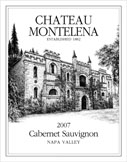Chatelena Montelena, Napa Valley (California) Cabernet Sauvignon, 2007 ($49): Some of the most extraordinary Cabernet Sauvignons that I have ever had from California have come from  Chateau Montelena. Many other wine critics probably make a similar claim; Chateau Montelena’s Cabernets are widely recognized as being among America’s finest.
Chateau Montelena. Many other wine critics probably make a similar claim; Chateau Montelena’s Cabernets are widely recognized as being among America’s finest.
Now that I’ve set the stage, let me qualify the immediate discussion. Chateau Montelena makes two Cabernets each year, and this 2007 is the lesser one -- not the legendary “Montelena Estate” Cabernet Sauvignon from the winery’s home vineyards, but the “Napa Valley” Cabernet. The “Estate” Cabernet hails specifically from the “best of the best” vineyards of the winery’s 115-acre estate in the Calistoga area of northern Napa Valley; this Napa Valley Cab, also from the Calistoga area, comes primarily from purchased fruit and grapes from a leased vineyard, although it usually includes some additional Montelena Estate grapes.
Chateau Montelena has made a second Cabernet since 1993. Originally, this wine was dubbed “Calistoga Cuvée,” but the winery changed that name in 2000, in support of the movement to recognize Calistoga as a sub-AVA of Napa Valley. That AVA finally became effective in January 2010, after years of wrangling. Because this wine was bottled in the Spring of 2009, it does not carry the new Napa Valley-Calistoga AVA, but future vintages will.
Chateau Montelena’s Napa Valley Cabernet might be the winery’s lesser Cab, but it is a very fine wine in its own right. The style of the 2007 is somewhat fruitier than the Estate Cabernet usually is -- slightly more Californian, less European in taste, if you will -- but the wine maintains the finesse and refinement that is Chateau Montelena’s trademark in Cabernet Sauvignon.
The wine’s aroma is very complex, with fruity notes (plum, dark berry), minerality (ink, pencil shavings), spiciness (from oak), and delicate floral and chocolate nuances. In your mouth, the wine is dry and full-bodied with powdery-soft tannins, rich but not dense texture, and very good concentration of fruit character at its core. The rear palate does show some firm tannins of oak, but these in no way dominate the wine. One characteristic that I particularly admire is the purity of the wine’s aromas and flavors. Another is the wine’s persistence across the full length of your mouth, without being cut short by high alcohol (although the wine does weigh in at 14.2 percent) or by tannin on the rear palate; the wine provides a textbook example of palate persistence. For the record, the wine spent 14 months in barrels of French and Eastern European oak, only 15 percent of which were new.
This wine hails from a particularly fine year in which grapes matured slowly and steadily with a boost of heat in late August, followed by evenly warm days and cool nights through the end of harvest in early October. I suspect that the winery will categorize 2007 as a “Goldilocks” vintage, a term it used for grouping the “just-right” 1986, 1997 and 2001 vintages in a vertical tasting of it Estate Cabernets two years ago.
This 2007 is supremely drinkable now, which of course would seem to part of its raison d’etre, but its harmony, concentration and balance suggest that it will improve over five years or so, and maintain good drinking for another three to five years after that.